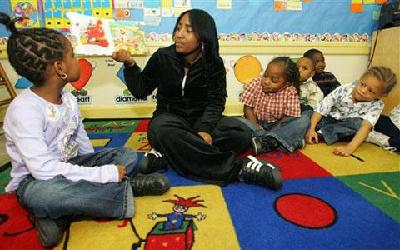
This is the VOA Special English Education Report.
Teachers and parents usually call attention to the pictures when they read storybooks to preschool children. But a new study suggests that calling attention to the words and letters on the page may lead to better readers.
The two-year study compared children who were read to this way in class with children who were not. Those whose teachers most often discussed the print showed clearly higher skills in reading, spelling and understanding. These results were found one year and even two years later.
Shayne Piasta, an assistant professor of teaching and learning at Ohio State University, was an author of the study. She says most preschool teachers would find this method manageable and would need only a small change in the way they teach. They already read storybooks in class. The only difference would be increased attention to the printed text.
Ms. Piasta says if you get children to pay attention to letters and words, it makes sense that they will do better at word recognition and spelling. But she says research suggests that very few parents and teachers do this in a systematic way.
The report appears in the journal Child Development.
More than 300 children age four and five were observed in classrooms in Ohio and Virginia. The children came from poor families and were below average in their language skills. This put them at risk for reading problems later.
For 30 weeks, the children took part in a program called Project STAR, for Sit Together And Read. The project is based at Ohio State. It tests the short-term and long-term results of reading regularly to preschool children in their classrooms.
Laura Justice at Ohio State was an investigator for the study. She heads the Preschool Language and Literacy Laboratory. She says one of the areas that interests researchers is known as the "locus of learning."
LAURA JUSTICE: "Where is it that a child learns something? Where is that space? We think we have identified it pretty well in terms of fostering young children's knowledge about print."
Professor Justice says this knowledge can be gained by having focused discussions when reading a book to a child.
LAURA JUSTICE: "We think we understand how information about print is transmitted from the adult to the child. And we think we developed this intervention that really helps adults center in on the things that we need and want children to learn."
There are different ways that adults can talk to children about print. They can point to a letter and discuss it, and even trace the shape with a finger. They can point out a word: "This is 'dog.'" They can discuss the meaning of the print or how the words tell the story. And they can talk about the organization of the print -- for instance, showing how words are written left to right in English.
And that's the VOA Special English Education Report, written by Jerilyn Watson. I'm Bob Doughty.
忙碌儿童综合症 hurried child syndrome
BBC TV teaches children yi, er, san
Can brain scans of young children predict reading problems?
(来源:VOA 编辑:旭燕)
关注和订阅


电话:8610-84883645
传真:8610-84883500
Email: languagetips@chinadaily.com.cn